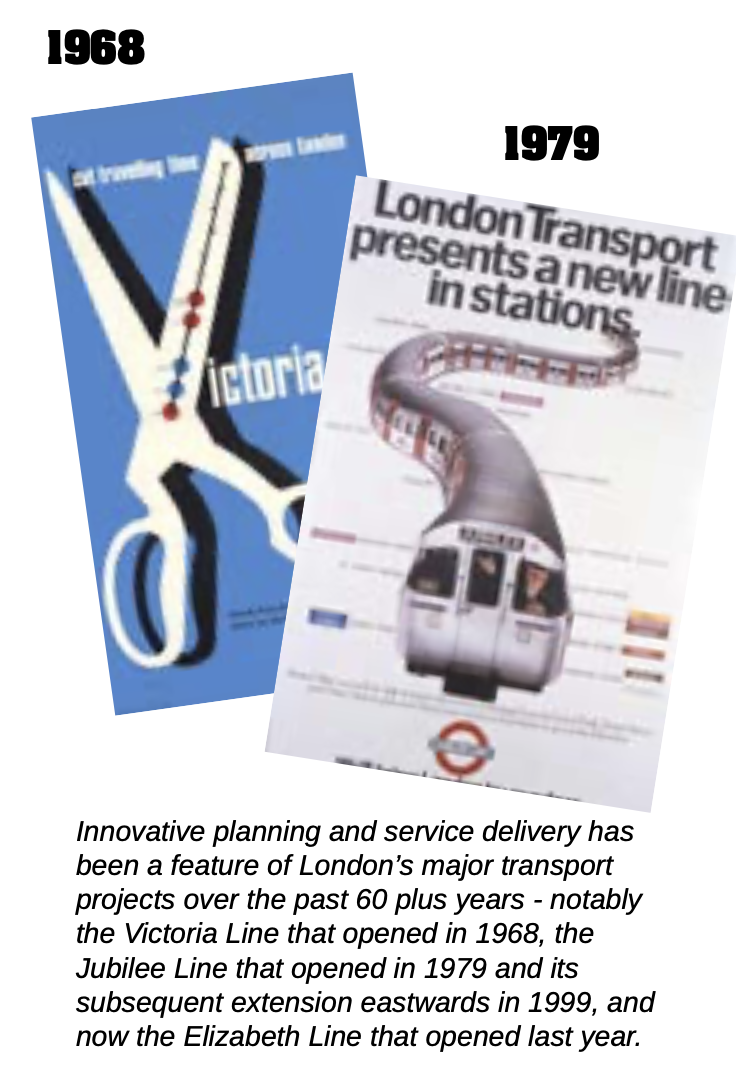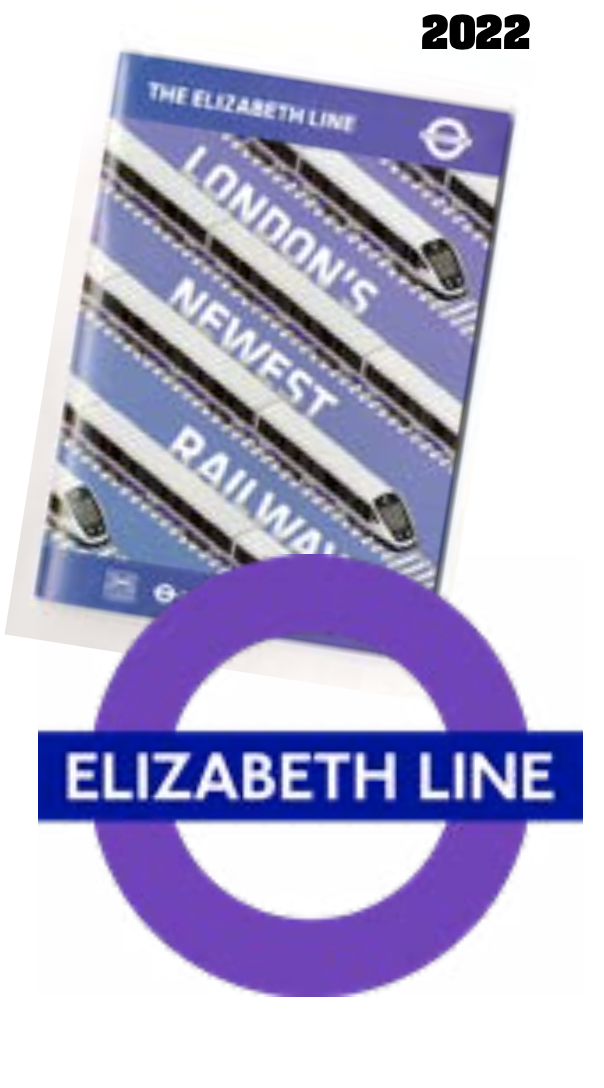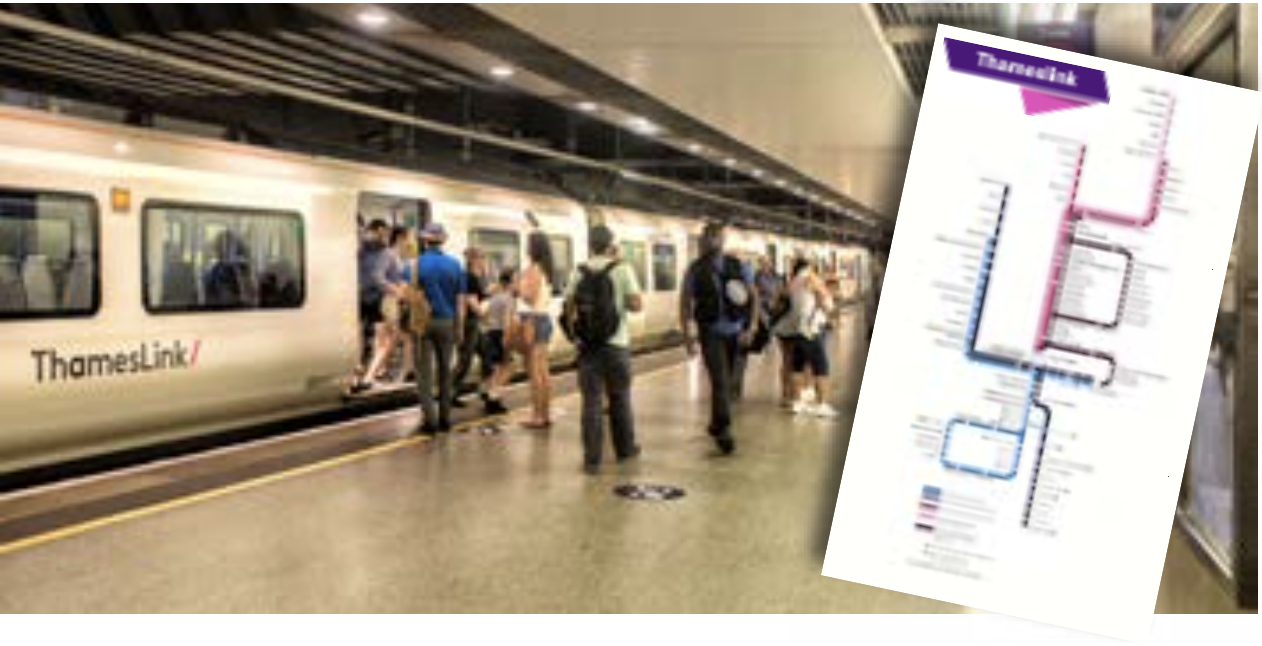TAPAS.network | 5 September 2023 | Examining Evidence | Elizabeth Line
TfL sets new best practice benchmark with approach to Elizabeth Line implementation and evaluation
A London tradition of comprehensive planning and implementation for major urban transport projects has been further refined with the addition of The Elizabeth Line to the network. Transport for London and its predecessors have had enviable resources – financial and professional – for such transformative schemes. Nevertheless, TfL’s approach, particularly that to monitoring and data analysis, can provide many useful lessons for projects by other authorities, as discovered when he spoke to the team at TfL.


Transport authorities around Britain - and the world - have long looked with a mixture of envy and frustration at the high level of resource devoted to delivering transport in the UK’s capital. This is not surprising, given the scale of the Metropolitan transport challenge and its high national profile. The development and delivery of projects has high critical visibility too. They are not only seen as national flagships, but their performance is often at the front of the firing line for political and media scrutiny.
The list of London’s significant and innovative major projects is a long one, stretching back to the beginnings of London Transport and its various subsequent incarnations, through to the current Transport for London era. Think Victoria Line and its innovative economic and social cost benefit justification, Jubilee Line funding and evaluation, Oyster and bank card ticketing system development, Congestion Charge design and management and now the arrival of the Elizabeth line (begun as Crossrail) with its ground-breaking construction and design elements and data-driven implementation and evaluation frameworks.
There were major delivery and funding problems along the way, but the actual operational outcome is proving to be positive, as our series of features on patronage and impacts – including the one in our previous issue – have demonstrated. The line seems set to play a very significant role in London’s transport network, if perhaps not quite the one originally envisaged way back in the 1950s when thinking about the idea of Crossrail first began.

The major idea of a dedicated fast cross London rail line reaching out into the Home Counties was first clearly outlined with the name Crossrail in the 1974 London Rail Study, and planned in detail in the 1980s. After significant delays in construction and commissioning of the services, it eventually opened as the Elizabeth Line last year.
So what can transport planning practitioners elsewhere learn from this project, and particularly from the approaches and techniques being deployed by the TfL professional team responsible for it? What are the lessons that can be learned from its further adjustment and the tracking of its impacts and implications in a changing transport and travel landscape?
TfL’s commitment to carefully evaluating the new service as early as possible has given the organisation an especially rich insight into how the Elizabeth Line and other TfL services relating to it can be optimised in the short term. It also provides firm evidence for inclusion in future business cases, including some which need to be prepared relatively soon.
As detailed in the last issue of LTT, TfL published a wealth of data on usage in July, only two months after the Elizabeth Line’s full timetable came into play.
The data already collected and the flow of information which is due to follow should ensure best value is obtained from the money already invested in the Elizabeth Line and steer that to be invested in future in taking full advantage of the line, and the quality and the capacity of the services and connections it offers.
Just hearing about all the data that is now flowing, and the invaluable insights into changing user behaviour and travel patterns raises the obvious question: why have no other UK transport projects been evaluated in comparable detail?
The £7bn Thameslink Programme, completed in 2019, also ushered in significant changes to the public transport map of London and South East England, but there has been little in the way of published evaluations of the programme’s effect on usage or its benefits, potential disbenefits and how outturns compared with forecasts. Nor has Thameslink’s most effective role in the London transport network and its coordination with it seemingly been properly discussed, it apparently being seen as very firmly just another piece of the franchised National Rail network. Even to the extent that it first appeared on, then was taken off, the London Transport map
Similarly , the rail industry undertook engineering analysis after the Great Western Electrification Programme cost more than forecast and was severely curtailed in geographic scope, but where was the analysis of the benefits for passenger and freight movements and the environment which the £2.8bn of expenditure achieved for its funders, the UK’s taxpayers?
It has to be said that Network Rail, and the rail operating industry ,have a very poor record of sharing- and probably even collecting- detailed data about the impacts of both infrastructure investment and significant changes to service patterns .
National Highways does at least conduct and publish Post-Opening Project Evaluations. However, there is a relatively long time lag between opening and POPE publication, during which lessons from the POPE are not available to inform development of further schemes. Forecasts of scheme benefits cannot always be compared with outturns, for a variety of reasons. Information about usage is broad-brush, with changes in overall traffic volumes accepted as sufficient rather than each POPE explaining and understanding how usage of the roads in the project area has changed.
Discussion with David Warner, TfL’s Principal Transport Planner, Transport Modelling, and David Arquati, TfL’s Principal Transport Planner, Development and Policy quickly reveals that one obvious advantage that TfL has had on monitoring the Elizabeth Line, and other recent schemes, is the wealth of data generated by the electronic ticketing system, including Oyster, contactless and smartphone payments. TfL’s data collection system was further boosted during the pandemic by the introduction of the DUNNART tool (see panel on page 22), which makes granular data available more rapidly than previously.
The slow and fragmented adoption of new digital ticketing systems on the rail network means comparable data is still not available for schemes outside Greater London, with the long promised South East Fares and Ticketing (SEFT) touch-in, touch-out project still to properly get underway. Monitoring and analysis of the Elizabeth Line, which extends to Reading and Shenfield, is not immune to this.
David Arquati explains: “We’ve had the benefit of being able to construct this data set because of the pandemic, but also there are bigger data gaps for those regional schemes. If we’ve got stuff in the Oyster and contactless area we have a much bigger treasure trove of data on travel patterns to be able to do that kind of evaluation.
“As you leave the contactless travel area, this becomes much more difficult. We’ve certainly found that, when we’ve been trying to look at some of the National Rail impacts from the Elizabeth Line, the data gaps are a lot bigger and we’ve had to do a lot more inference than we’ve done for the TfL areas.
“Some places in the London area have got more than 90% of people using Oyster cards [or contactless payments] so you’ve captured almost every journey using a smartcard tap, and that gives you a much bigger data set. From somewhere like Brighton, Haywards Heath or Littlehampton, a lot of people are using paper tickets or tickets where you’re just not getting that level of detail.
“It’s much harder to see what people’s travel patterns are when they in to central London, in particular.”

In some ways, the development of Thameslink North-South services through London mirrors the offer of new connections made to travellers by the Elizabeth Line. But as a part of the National Rail network rather than the TfL system, the level of integration within the London network is much lower and little detailed data collection and evaluation has been undertaken.
He says that TfL is not seeing the full picture at Farringdon, for example ,where Thameslink interchanges with the Elizabeth Line. “We would like to see if they’re getting on a train at East Grinstead and then going on to Paddington. We just can’t have that level of detail.”
Is that a result of the data being held by Govia Thameslink Railway or the DfT rather than TfL?: “A lot of it isn’t held by anybody” Arquati replies. “There are lots of good data that the TOCs [Train Operating Companies] have about load weight, particularly on newer trains, just like we do, but if you want to see where people are going from and to, there’s a generational difference between a smartcard system and the traditional National Rail paper ticket.”
He clearly hopes that the continuing expansion of the contactless ticketing area on National Rail in the South East will capture richer data from a wider area.
David Warner says he is not aware of there having been any evaluation study done by the DfT on the Thameslink Programme. “I don’t think it’s something they’ve been looking at, but equally their service has changed a lot [since scheme development].” He would expect any evaluation monitoring to have sought to capture the impacts of Thameslink on the Underground network and buses, but does not think TfL has been asked for such data or analysis.
In some of the extremities of the Thameslink map, the services planned before the pandemic have still not been implemented, which would have some impact on comparisons of forecast and observed usage. Warner contrasts this with full delivery of the Elizabeth Line service as planned, albeit more than two years late.
Even with its rich data on Elizabeth Line passenger journeys, TfL has not received all of the desired analysis on a plate. TfL’s estimates of abstraction from other modes, for example, involved comparing trends in flows which the Elizabeth Line has affected with flows unaffected by the project. To co-ordinate and synthesise its own insights ,TfL has a benefits forum to “make sense of the findings across discipline boundaries for onward discussion and engagement with senior management, stakeholders and the public”.
It has also commissioned Arup to undertake the Elizabeth Line’s first post-opening study, which will gather baseline information on wide socio-economic impacts. This will include surveys to establish why people are using the Elizabeth Line – something TfL’s data does not reveal as it is intended to understand the what rather than the why at this stage. The new line’s impact on road use will be assessed using mobile network data.
Similar work was undertaken in a ground-breaking impacts study of the Jubilee line extension undertaken by the Transport Studies Group of the University of Westminster for TfL and the Department for Transport and published in 2004. There are parallels now in tracking the relationships of transport service use, urban development and land value changes – invaluable in making the case for ‘benefit capture’ and innovative funding models like that put in place to support funding of the Crossrail project from business.
Construction of the central section of the Elizabeth Line, then known as Crossrail, was unusual among UK transport infrastructure projects in having major funding from the private sector. The Business Rate Supplement and Mayoral Community Infrastructure Levy raised money from larger business and non-domestic premises in London.
There were also contributions to specific elements of the project, such as funding from Berkeley Homes towards the cost of adding a station at Woolwich to the Elizabeth Line. Woolwich station also benefited from Greenwich Council’s own Community Infrastructure Levy.
TfL’s Elizabeth Line analyses now enable private-sector funders to understand what their financial contributions are achieving. To supplement the data already published, TfL has started a review of the Crossrail financing model with the intention of producing an objective and factual account of the project’s funding and financing.
“The Crossrail story is relevant to other projects in London and the UK and is also much discussed internationally. The team will aim to concentrate on what matters for the future rather than rework past negotiations,” TfL told members of the Elizabeth Line Committee in July. “The review will also consider why the Crossrail mechanisms and approach are talked about widely but have not so far been adopted by other UK cities or copied internationally.”
Other cities have every reason to look closely at the data emerging from the Elizabeth Line in the current climate of rapid cost inflation and severe constraints on public funding. The data could arm them with facts about the power of large-scale public transport investment to transform local economic patterns and enhance property and land values.
TfL believes there could be “more specific but still rich learning from” various aspects of the funding model, including third-party contributions to the costs of individual stations, the relationship with Heathrow Airport and its regulator, the capacity for over-station development, and the timings and profile of particular receipts.
Warner adds that some private-sector organisations are already doing their own analyses of the Elizabeth Line’s benefits for their particular areas. He references the Canary Wharf Group, which owns many offices near a major Elizabeth Line station, and the West End Partnership, representing shops and other businesses in London’s West End.
He says the partnership has been looking at property impacts. “They can tell you things like how many coffee shops appeared and how many new tenants are appearing in offices around the route. They’re starting to do some analysis of what’s going on.” The partnership has seen TfL’s latest reports on usage, and TfL is equally interested in the partnership’s data.
Arquati says TfL is part of a regular Canary Wharf transport forum which shares information on what is going on in that area.
So far, there is no analysis of how the Elizabeth Line has changed land values, although Warner says there is information about sites where new property has been built above a station.
Capturing data on uplifts in land value will be a longer-term task than analysing usage. Some change is likely to have begun during Crossrail’s construction, when the transformative nature of the future new service was clear. Similarly, other changes in land value could materialise in the years to come, particularly in some of the suburbs where the previous National Rail services have benefited from conversion to Elizabeth Line operation.
Arquati comments: “There’s so much development happening around the stations, particularly on the south eastern leg but also the big town centres like Ilford and Romford.” He says this will stimulate more growth in Elizabeth Line usage.
He thinks it inevitable that Elizabeth Line data will strengthen TfL’s case for investing in other major projects, such as the Bakerloo Line extension to Lewisham. Before then, the data will support the business cases for further investment in the Elizabeth Line, including the proposed additional trains to enable enhancement of service frequency west of Paddington to serve Old Oak Common while the latter is the temporary terminus of HS2.
Running more trains to Heathrow or Reading would be ideal – currently many turn back at Paddington – but Warner says there are capacity constraints on the Great Western main line. Elizabeth Line trains share track there with heavy freight trains, which play an important part in a growing London through supplying the aggregates which enable construction projects to proceed. There is no question of removing the freight trains, but TfL would like to optimise timings.
Other western options which TfL looked at in the past included continuing from the Old Oak Common area to Wembley, where the Elizabeth Line would replace the current London Overground local service out of Euston, or to Richmond, where the Elizabeth Line would help to relieve the heavily used lines in and out of Waterloo.
The extension candidate under most active scrutiny currently is to Ebbsfleet in Kent. This scheme, developed independently of TfL, would be an extension along the existing railway route east of Abbey Wood, but the cost is expected to be above £3bn. Issues which would need to be resolved include operational constraints and the incompatible electrification east of Abbey Wood, where third rail supply is installed but the Elizabeth Line trains work only from overhead supply.
An obvious natural advantage for TfL in evaluating as well as planning projects is that so much of Greater London’s transport system is now under its control. The take-over of Overground Lines in the last few decades has been a major addition in this respect – as the huge boosts in patronage have confirmed – and has once again provided a valuable evidence base for the justification of investment in upgrading of what were once under-used ‘Cinderella’ lines.
David Arquati illustrates the benefits of wide-scale devolution in London with the case of the Docklands Light Railway, where rolling stock was reallocated in accordance with the forecast changes arising from the Elizabeth Line’s opening. “We changed the [DLR] timetable. We reduced the train length of some of the services to be able to move capacity around so that we could add more frequent services that linked to the Elizabeth Line.
“Spreading the benefit is one of the big advantages [of transport devolution], and then we have teams here that look very closely at land use and development. We’re involved statutorily in development control, and so we can use all those things towards the same goal.”
That benefit is two-way. Transport modellers can gain an understanding of where development will generate additional demand in the future, while the land use planners gain an insight into how investments in transport schemes are expected to affect land values, travel to work areas and demand for housing and facilities.
Warner refers to the halving of passengers on the Central Line service from Ealing Broadway since the Elizabeth Line reduced journey times to central London and beyond. “The fact the Elizabeth Line is there has meant it’s been possible to take [Central Line] trains out of service and refurbish them.” That would have been more complex to achieve had the two services not been under TfL’s control.
TfL also has the bus network under its control, he points out. “Buses are more flexible by their nature and we’ve been able to change the service [to pre-empt and reflect the Elizabeth Line effect].” He doubts that this could be done “in a privately operated system that you see outside of London in quite such a quick way” and asks: “Would the bus companies be prepared to take the risk before the Elizabeth Line opened, for example, to put new bus routes in or divert them or whatever it may mean, or even properly understand where the routes need to go?”
Arquati says the same integrated transport team in TfL models bus and rail. His bus colleagues sit next to him and Warner.
In contrast, National Rail data is spread across many organisations, while highways data is held by local government as well as the UK’s trunk road agencies, and is often scheme- specific . After a similar long standing lack of information on bus use ,the DfT’s recently introduced Bus Open Data Scheme is addressing some of the data silos of the bus network in England outside London.
TfL’s determination to understand the Elizabeth Line project’s impact is surely an exemplar for other organisations to establish comprehensive data sets from which analysts can tease out significant policy-related conclusions . Such work does cost money, but without it there is a greater risk that significant funding for future schemes will not be spent in the most effective ways and a risk that recently completed schemes are not optimised to deliver the greatest possible benefits.
TfL Experts we spoke to for this article


TAPAS appreciates the assistance provided by TfL in the preparation of this article. We spoke with David Arquati, TfL’s Principal Transport Planner, Development and Policy (far left/above) and David Warner, TfL’s Principal Transport Planner, Transport Modelling (near left/below), and would also like to thank Geoff Hobbs, Director of Public Transport Service Planning for his valuable insights.

Rhodri Clark is a specialist transport writer based in North Wales. He has been contributing to Local Transport Today magazine since the 1990s, primarily on Welsh subjects. He appears on Welsh radio and TV to comment on transport issues.
You are currently viewing this page as TAPAS Taster user.
To read and make comments on this article you need to register for free as TAPAS Select user and log in.

Log in